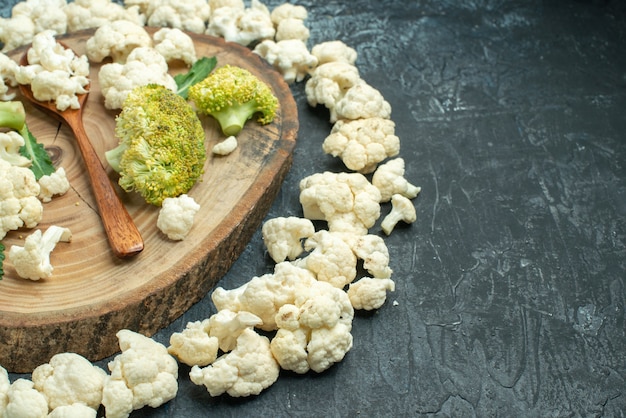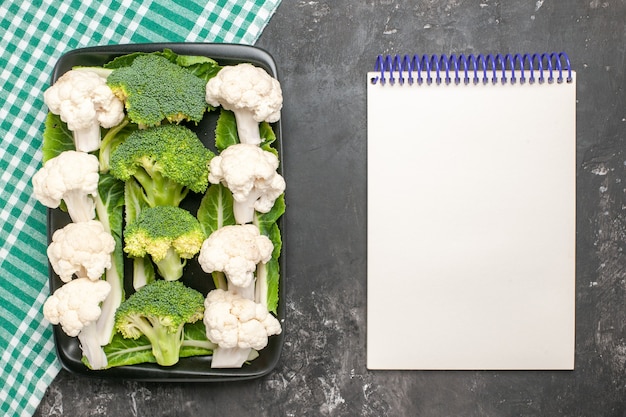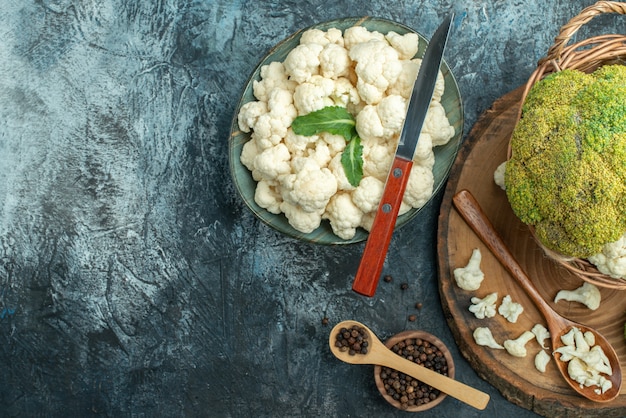Cauliflower. It’s one of those vegetables that’s always been there, quietly lurking in the crisper drawer, ready to be transformed into something delicious. And while it’s often relegated to the role of a side dish, I firmly believe cauliflower deserves a starring role. A perfectly roasted cauliflower, golden brown and tender, is a thing of beauty. It’s a symphony of textures and flavors, a versatile canvas for culinary creativity.
But getting that perfect roast, that magical combination of crispy edges and melt-in-your-mouth tenderness, is a bit of a culinary art. It takes a keen eye, a steady hand, and a little bit of know-how. That's where this guide comes in. I've been roasting cauliflower for years, and I've learned a thing or two about how to create a truly sensational result. So, grab a cuppa, settle in, and let me share my secrets.
Part 1: The Basics of Baking a Cauliflower

1. Choosing the Right Cauliflower
The first step to any great cauliflower roast is selecting the perfect specimen. You want a head that’s firm and white, free from any blemishes or signs of wilting. Imagine a cauliflower the size of your fist – a good balance of size and potential for deliciousness. Of course, if you're planning a large gathering, you might need a bigger one, or if you're just cooking for yourself, a smaller one will do just fine.
Now, there’s the question of whether to use the whole cauliflower or chop it into florets. It depends entirely on your desired outcome. If you're aiming for a whole roasted cauliflower, a show-stopping centerpiece, leave it whole and revel in its inherent majesty. If you're envisioning a side dish, a cauliflower cheese, or a stir-fry, florets are your go-to option, offering versatility and ease of preparation.
2. Preparing the Cauliflower for Oven Baking
Once you've got your cauliflower chosen, it's time to give it a good wash. Run it under cold water, gently removing any loose leaves or dirt. Next, trim off any damaged leaves, leaving behind a pristine canvas for your culinary masterpiece.
Now, for a crucial tip: before you roast, toss the cauliflower in a bit of olive oil, salt, and pepper. This simple act of pre-seasoning works wonders. The olive oil helps create that gorgeous golden brown color, while the salt and pepper enhance the natural flavors of the cauliflower. It's like giving your vegetable a spa treatment before it takes center stage.
3. Oven Time and Temperature: The Magic Formula
The oven is where the magic happens. The baking time for cauliflower depends on a few factors: the size of the cauliflower, whether it’s whole or in florets, and the temperature of your oven. But as a general rule of thumb, a whole cauliflower will take about 45-60 minutes at 200 degrees Celsius (400 degrees Fahrenheit), while florets need around 25-30 minutes.
To ensure your cauliflower is cooked to perfection, use a skewer or knife to test it. It should be tender when poked, and the florets should have developed a hint of crispness on the edges. It’s a dance of textures, a delicate balance between tenderness and a delightful bite.
Part 2: Mastering the Roast: Elevate Your Cauliflower Game

Now that we’ve laid the groundwork, let’s delve into some of the tricks and techniques that can take your cauliflower roast from good to absolutely sensational.
1. Achieving That Perfect Crispy Edge
Who doesn't love that beautiful golden brown color and the satisfying crunch of a perfectly roasted cauliflower floret? There's a little trick I've learned over the years to achieve that crispy perfection. Before you pop the cauliflower into the oven, sprinkle it with a bit of flour. It helps absorb some of the moisture, creating a crispy crust that’s both visually appealing and incredibly delicious.
But why stop there? Flour is just the beginning. Get creative! Experiment with other coatings like breadcrumbs, grated Parmesan cheese, or a sprinkle of smoked paprika. These little additions not only add texture but also bring a whole new dimension of flavor to your roast.
2. Flavor Infusion: Beyond the Basics
Roasted cauliflower is delicious on its own, but let's be honest, why settle for just delicious? Let's add some depth, some excitement, some bold and beautiful flavors! There are endless possibilities for enhancing the taste of your cauliflower.
Here are a few of my favorite flavor-enhancing combos:
- Garlic and Herbs: A timeless classic. Simply add a few chopped garlic cloves and fresh herbs like rosemary, thyme, or oregano to the roasting pan. The aroma alone is enough to make your mouth water.
- Cumin and Coriander: For a warm and spicy kick, sprinkle a teaspoon or two of ground cumin and coriander. This combination is a gateway to a whole world of flavor.
- Lemon and Pepper: A refreshingly tangy combination. Squeeze some lemon juice over the cauliflower and add a generous sprinkle of freshly ground black pepper. The acidity of the lemon cuts through the richness of the cauliflower, creating a balanced and satisfying taste.
- Curry Powder: For a touch of Indian flair, add a teaspoon or two of curry powder to the roasting pan. The warmth of the curry powder adds a delightful complexity to the overall flavor profile.
- Smoked Paprika: A touch of smoky depth adds a whole new dimension to the roast. Smoked paprika, with its rich and smoky flavor, is a versatile ingredient that elevates any dish.
Remember, these are just suggestions. Feel free to experiment and discover your own unique combinations. There’s no right or wrong way to add flavor, only the joy of creating something delicious and your own.
3. Maintaining Moisture: A Juicy and tender roast
One of the common challenges with roasting cauliflower is preventing it from drying out. Don't worry, there are ways to ensure a juicy and tender result. Adding a bit of liquid to the roasting pan is a simple yet effective solution. You can use a splash of water, a little bit of stock, or even a splash of white wine. The liquid creates steam, helping to keep the cauliflower moist and tender.
Another trick is to wrap the cauliflower in foil for the first part of the cooking time. This traps the moisture, promoting a tender interior. Then, remove the foil for the last 10-15 minutes to allow the cauliflower to brown and crisp up. It's a balancing act, achieving both tenderness and a beautifully browned exterior.
Part 3: Serving Up Perfection: A Feast for the Senses

Now, it's time to unveil your culinary masterpiece. The moment of truth has arrived. You've got your perfectly roasted cauliflower, and now it's time to showcase its beauty and its flavor.
1. The Art of Accompaniments: A Culinary Symphony
Roasted cauliflower is so versatile that it pairs beautifully with a wide range of accompaniments. You can go with a classic pairing, like mashed potatoes and gravy, or explore more adventurous combinations. It's all about creating a balance of flavors and textures.
Here are a few ideas to get your creative juices flowing:
- Salad: A fresh and vibrant salad, like a simple green salad with a lemon vinaigrette, provides a refreshing contrast to the richness of the roasted cauliflower. It's a combination that delights the palate.
- Roasted Vegetables: Why limit yourself to just cauliflower? Roast other vegetables like sweet potatoes, carrots, or broccoli to create a colorful and flavorful medley of goodness. The possibilities are endless.
- Rice or Couscous: A fluffy bed of rice or couscous is a perfect base for your roasted cauliflower, offering a neutral canvas that allows the cauliflower to shine. It's a classic combination that always works.
- Dipping Sauces: Don't forget about dipping sauces! A classic garlic mayonnaise is always a winner, but why not experiment with something a little more adventurous? A spicy chimichurri sauce, a creamy pesto, or a tangy yogurt dip can add a whole new dimension to your cauliflower roast.
Remember, the best accompaniments are those that complement the flavors and textures of the roasted cauliflower, creating a harmonious blend of tastes and sensations.
2. The Importance of Presentation: A Culinary Work of Art
Don't underestimate the power of presentation. A beautifully presented dish is more appealing, making the food taste even better. For a whole roasted cauliflower, place it on a platter, surrounded by your chosen accompaniments. If you're serving cauliflower florets, arrange them artfully on a bed of rice or couscous, or use a ramekin for a more elegant presentation. It's all about showcasing your culinary creations in the most appealing way possible.
3. The Finishing Touch: A Garnish to Enhance the Delight
A simple garnish can truly elevate your dish, adding that final touch of visual appeal and culinary finesse. Try adding a sprinkle of chopped fresh herbs, a squeeze of lemon juice, or a drizzle of olive oil. You can even get creative with edible flowers or toasted nuts. It's those little details that can transform a dish from ordinary to extraordinary.
Part 4: Beyond the Basics: Delicious cauliflower recipes
You're probably thinking, "This all sounds wonderful, but I want some real recipes!" And you know what, I’m right there with you. Roasted cauliflower is so versatile that it can be used in all sorts of dishes, from simple side dishes to show-stopping main courses.
1. Roasted Cauliflower with Garlic and Herbs
This classic recipe is perfect for a simple weeknight meal. It’s a symphony of flavors, combining the warmth of garlic with the earthy notes of fresh herbs.
Ingredients:
- 1 medium-sized cauliflower
- 2 tablespoons olive oil
- 2 cloves garlic, minced
- 1 teaspoon dried rosemary
- 1 teaspoon dried thyme
- Salt and pepper to taste
Instructions:
- Preheat your oven to 200 degrees Celsius (400 degrees Fahrenheit).
- Cut the cauliflower into florets.
- Toss the florets with olive oil, minced garlic, rosemary, thyme, salt, and pepper.
- Spread the florets in a single layer on a baking sheet.
- Roast for 25-30 minutes, or until tender and slightly crispy.
2. Roasted Cauliflower with Curry Powder
For a touch of Indian flavor, this recipe is a delightful adventure for the palate. The warmth of the curry powder adds a unique depth to the roasted cauliflower.
Ingredients:
- 1 medium-sized cauliflower, cut into florets
- 2 tablespoons olive oil
- 1 teaspoon curry powder
- Salt and pepper to taste
Instructions:
- Preheat your oven to 200 degrees Celsius (400 degrees Fahrenheit).
- Toss the cauliflower florets with olive oil, curry powder, salt, and pepper.
- Spread the florets in a single layer on a baking sheet.
- Roast for 25-30 minutes, or until tender and slightly crispy.
3. Roasted Cauliflower with Lemon and Pepper
This recipe is a refreshing twist on the classic roast, adding a burst of tanginess and a touch of zest. The combination of lemon and pepper is a perfect balance of flavors, complementing the roasted cauliflower beautifully.
Ingredients:
- 1 medium-sized cauliflower, cut into florets
- 2 tablespoons olive oil
- Juice of 1 lemon
- Freshly ground black pepper to taste
Instructions:
- Preheat your oven to 200 degrees Celsius (400 degrees Fahrenheit).
- Toss the cauliflower florets with olive oil, lemon juice, and black pepper.
- Spread the florets in a single layer on a baking sheet.
- Roast for 25-30 minutes, or until tender and slightly crispy.
Part 5: Cauliflower: A Culinary Champion
As I delve deeper into the world of cauliflower, I've come to realize it's more than just a vegetable. It's a culinary champion! It's healthy, versatile, affordable, and unbelievably tasty. Whether you're a seasoned chef or a culinary novice, you can always rely on cauliflower to deliver a delicious and satisfying meal. It's a kitchen staple that deserves a place of honor on your table.
Part 6: Cauliflower Storage and Leftovers: Getting the Most Out of Your Cauliflower
You've got your perfectly roasted cauliflower, you've served it up with all the trimmings, and you've got a bit left over. Don't worry, there's no need to toss it! Leftovers are a culinary treasure, a chance to create new and exciting dishes.
1. Storing Your Cauliflower: Keeping it Fresh
If you have a whole cauliflower that you haven't roasted yet, you can store it in the refrigerator for up to a week. Wrap it tightly in plastic wrap or store it in a sealed container. For pre-cut florets, use them within a couple of days. Store them in an airtight container in the refrigerator.
2. Leftover Love: Giving Leftover Cauliflower a New Life
Leftover roasted cauliflower is a culinary chameleon, adaptable and delicious in a variety of dishes. It's a fantastic addition to salads, soups, or a quick and easy pasta dish. Get creative and use it to make a cauliflower frittata or cauliflower cheese.
Part 7: Cauliflower FAQs: Addressing Your Cauliflower Concerns
You've got questions, I've got answers. Let's address some of the most common questions about roasting cauliflower.
1. What is the best way to cut a cauliflower for roasting?
It depends on what you're making. For a whole roasted cauliflower, leave it as is or cut it into quarters. For cauliflower florets, chop them into bite-sized pieces or leave them a bit larger, depending on your preference. Just make sure the pieces are similar in size so they cook evenly. A consistent size ensures that every piece is cooked to perfection.
2. Can I roast cauliflower with the skin on?
You can, but it's not always the best idea. The skin can be tough and chewy, and it may not get as crispy as the florets. If you do want to roast with the skin on, give it a good scrub and remove any tough outer leaves. You can also score the skin with a knife to help it cook more evenly. The key is to prepare the skin for a successful roast.
3. How can I tell if my cauliflower is cooked?
The easiest way is to check it with a skewer or knife. It should be tender when poked. The florets should also be slightly crispy on the edges. If the cauliflower is still hard, it needs more time in the oven. If it's starting to brown too much, reduce the oven temperature a bit. It's a delicate balance, looking for that perfect texture and color.
4. What if my cauliflower is dry?
If your cauliflower is a little dry, add a bit of liquid to the roasting pan. This could be a splash of water, a little bit of stock, or even some white wine. The liquid will help to steam the cauliflower, making it tender and juicy. It’s all about finding that perfect moisture balance.
5. Can I freeze roasted cauliflower?
You can, but it's best to freeze it before it's roasted. Once it's roasted, it can become a bit mushy when frozen. If you do want to freeze roasted cauliflower, let it cool completely before storing it in a freezer-safe container or bag. Freezing it raw preserves its texture and prevents it from becoming soggy.
Part 8: The Verdict: Cauliflower for the Win!
There you have it – my complete guide to roasting cauliflower. It's a simple process, but there are a few tricks to make sure you get it just right. So, give it a go! Experiment with different flavors, try new recipes, and most importantly, have fun with it. You'll be surprised at just how delicious cauliflower can be. It's a versatile vegetable that can truly shine with a little creativity and a touch of know-how.
Now, if you'll excuse me, I think I'm going to make myself a nice cauliflower cheese. It's been a long day, and there's nothing better than a comfort food classic. And who knows, maybe I'll even try a new variation, incorporating some of the tips and tricks I've shared with you. The possibilities are endless, and the adventure is just beginning.
Everyone is watching

Prime Rib Roast Cooking Time Chart: Per Pound Guide
Cooking TipsPrime rib roast. Just the name conjures images of lavish dinners, crackling fires, and hearty laughter. It’s ...

How Long to Bake Potatoes in the Oven (Perfect Every Time)
Cooking TipsBaked potatoes are a staple in my kitchen. They're incredibly versatile, delicious, and surprisingly easy to m...

Perfect Rice Every Time: The Ultimate Guide to Cooking Rice
Cooking TipsAs a self-proclaimed foodie, I've always been a bit obsessed with rice. It's the foundation of countless cuisi...

The Ultimate Guide to Cooking Asparagus: Tips, Techniques, and Recipes
Cooking TipsAsparagus. The mere mention of this spring delicacy conjures up images of vibrant green spears, crisp and burs...

Ultimate Guide to Cooking the Perfect Thanksgiving Turkey
Cooking TipsThanksgiving. Just the word conjures up images of overflowing tables laden with delicious food, the scent of r...
